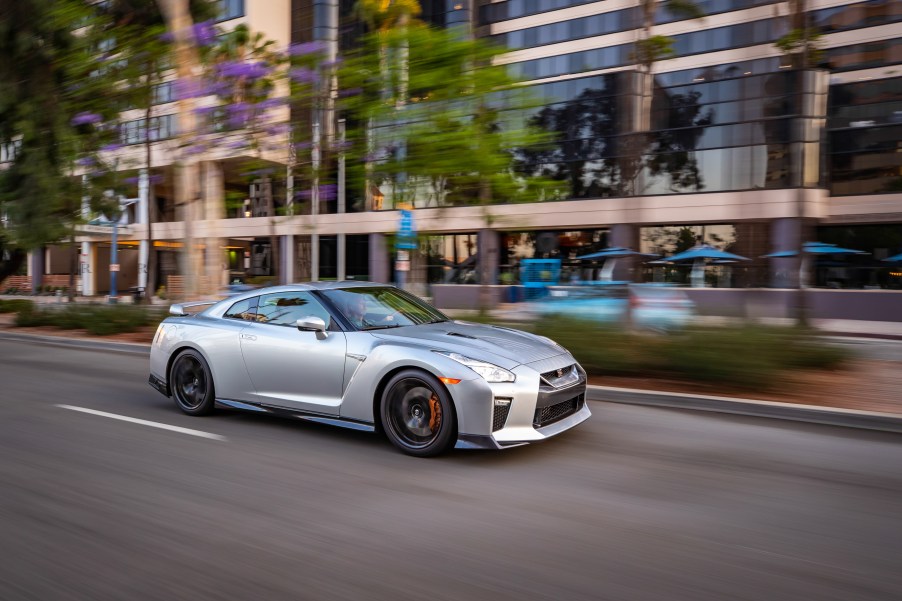
Would the Nissan GT-R Make a Good Daily Driver?
The short answer to the question is most likely “yes.” Since the Nissan GT-R has four seats, a decent trunk and all-wheel drive (for snowy states). But let’s take a closer look at the specs and really figure out if this Japanese supercar can double as a reliable grocery-getter on the daily.
Godzilla’s arrival

The R35 Nissan GT-R, also known as “Godzilla,” hit our shores back in 2008 bringing with it a huge dose of horsepower (480 hp), physics-defying suspension, and a Transformer-like look. It got rave reviews from journalists and consumers alike and was considered a wild card in the supercar segment, thanks to its’ more affordable-price range of $60,000-80,000.
It’s been about 12 years since its debut and the GT-R has gone through some changes. It’s now offered in four different trims: Premium, 50th Anniversary, Track Edition, and Nismo; all of which command a more-supercar-like sticker price of $115,000 to $212,335.
The latest iteration of the GT-R still has the same 3.8-liter twin-turbocharged V6 engine that it always had, but now produces 565 horsepower, which is routed through a six-speed dual-clutch automatic transmission. In case you need more power, the higher-priced Nismo and Track Edition make an even 600.
All of this power and traction is good for propelling the car to 60 mph in about 2.9 seconds and the suspension is designed to handle every last bit of it. It utilizes a multi-link suspension in the rear and a control-arm suspension up front with Bilstein shocks all around.
The suspension can be controlled in-cabin via a set of switches. If needed, the driver can always put the car in “Comfort” for daily driving, or “R Mode” when a stoplight drag race is in order.

Practicality still exists
Taking a closer look at the non-performance specs, the GT-R does have four seats and a trunk. The cargo capacity measures in at 8.8 cubic feet, which sounds small and it is, but you can actually fit a decent amount of groceries and medium-sized items in it. Just don’t do any crazy Costco runs.
Seating space is limited, the overall passenger volume measures in at 79 cubic feet. For reference, the current Nissan Sentra’s passenger volume is 94 cubic feet. So, leave your tall friends at home, or tell them to meet you at the destination in their Sentra.
Fuel economy is yet another factor as the GT-R achieves 16 mpg in the city and 22 on the highway, 18 mpg combined. It’s not terrible if you can keep your lead foot from sinking the gas pedal too much, but that would be doubtful. So be prepared to slide your credit card in the gas pump on a weekly basis.

My personal experience
I had the chance to drive a Nissan GT-R back in 2008 when I first came out, and again in 2009. My time with the car was very brief, but luckily, I did drive it on regular roads and on the freeway. Needless to say, it was fast.
The torque comes on in a different way than any other turbocharged car in that at the higher RPM range, it pushes you back with a huge surge of power at an almost vision-blurring rate while engine and exhaust noises fill the cabin. I did put the car in Comfort mode, which did soften the ride up, but it was still a little jarring over speed bumps and dips. It can be driven normally, but it’s smoother when driven fast.
Can it be daily driven?
We would still say “yes, but not comfortably.” The insane amount of power is a blast on empty roads and the suspension can handle any corner you throw the car into, but the ride comfort is negligible at best, even in Comfort mode. A long road trip would probably be more comfortable than it would be in say, a Lotus Elise. But the paltry gas mileage would be a drag.
Then again, if you’re brave enough to drive a GT-R for more than the average track day, then you probably don’t care much about fuel economy or comfort. Ultimately, we recommend the Nissan GT-R to be driven daily, as long as your funds allow, and your friends don’t mind driving separately.



